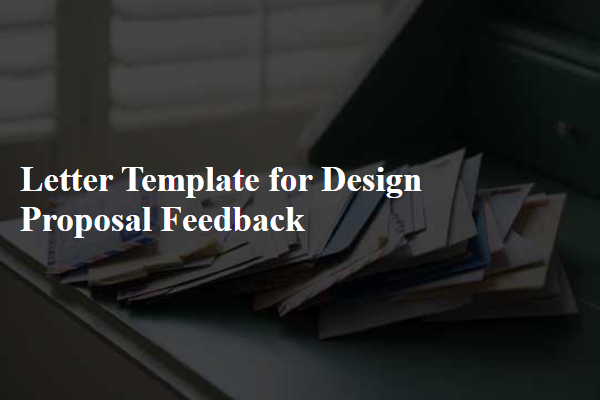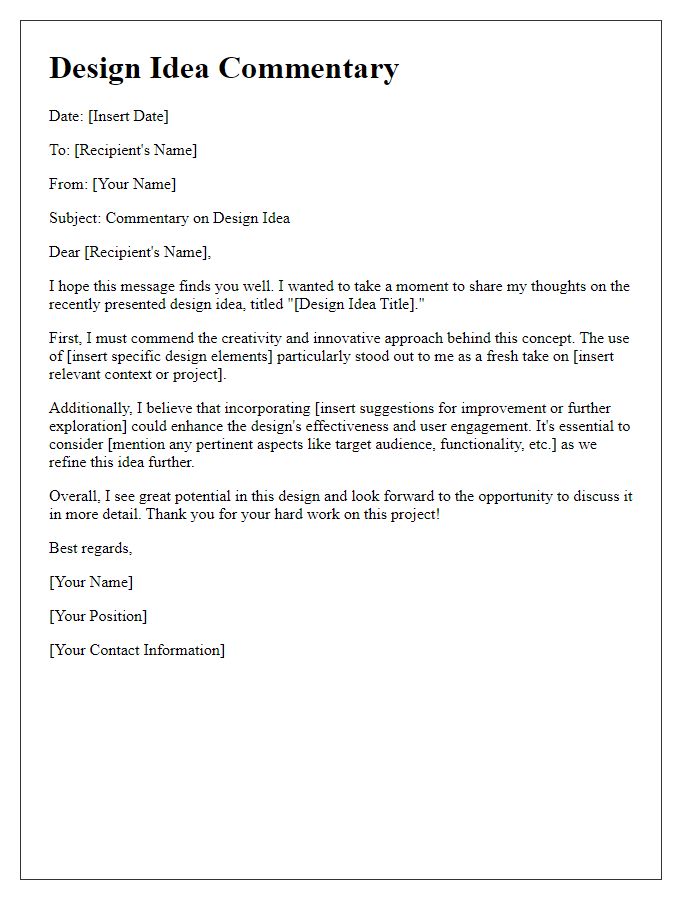Hey there! If you've ever submitted a design proposal, you know how essential it is to get constructive feedback. It not only boosts your creativity but also sharpens your skills for future projects. In this article, we're diving into a simple yet effective letter template that can help you request feedback on your design proposals. So, grab a cup of coffee and let's explore how to enhance your communication with clients and collaborators!

Clarity and coherence of the proposal
A design proposal's clarity ensures stakeholders grasp the project's goals, objectives, and timelines effectively. Coherence binds the proposal's elements--concepts, visuals, and timelines--into a unified narrative, making it easier to follow. Key elements include concise language, structured layouts, and appropriate visuals. Clear segmentation of different sections, such as Introduction, Objectives, Design Process, and Conclusion, aids in navigation. Engaging visuals, including mood boards and wireframes, can communicate ideas swiftly. Additionally, consistent formatting and the use of straightforward terminology enhance comprehension, allowing stakeholders to quickly provide informed feedback and support the project's advancement.
Relevance of design aesthetics
Design aesthetics play a crucial role in influencing user perception and engagement with products. Factors such as color schemes, typography, and layout contribute to the visual appeal and emotional response from users. For instance, the use of harmonious color palettes can enhance brand identity and evoke feelings, while thoughtful typography improves readability and user experience. Additionally, the layout influences the flow of information and navigational ease, directly impacting user satisfaction. In competitive markets, designs that prioritize aesthetics not only attract attention but also foster brand loyalty and increase conversion rates, making them essential for effective marketing strategies.
Feasibility and budget alignment
In evaluating design proposals, feasibility is assessed based on technical requirements, materials selection, and construction methods, ensuring alignment with project goals and timelines. Budget alignment examines the total cost estimates, examining potential variances against allocated funding. Potential financial constraints may arise from unforeseen expenditures, necessitating a contingency allowance. Stakeholder engagement, including reviews from the project management team and financial analysts, significantly influences viability, underscoring the importance of strategic forecasting within both design and cost parameters. Thorough documentation enhances clarity, facilitating informed decisions regarding adjustments or approvals to optimize project outcomes.
Innovation and originality
Innovative design concepts play a crucial role in enhancing user engagement and brand identity. Unique approaches in design can differentiate products in competitive markets, leading to increased market share and customer loyalty. Originality reflects a brand's values and vision, resonating with target audiences and fostering emotional connections. For example, incorporating sustainable materials in product design not only appeals to environmentally-conscious consumers but also positions the brand as a leader in eco-friendly practices. Additionally, utilizing cutting-edge technologies, such as augmented reality, can provide immersive experiences that captivate users, enhancing their interaction with the product. Overall, innovation and originality in design are essential for driving growth and establishing a distinct presence in a saturated marketplace.
Alignment with brand values and goals
A design proposal that aligns with brand values and goals plays a critical role in reinforcing the identity of a company. The alignment ensures that visual elements resonate with target audiences and reflect core principles emphasized by the brand, such as sustainability, innovation, or customer-centricity. For instance, brands like Patagonia prioritize environmental friendliness, which influences their sustainable design choices. Similarly, tech companies like Apple focus on minimalist aesthetics that convey simplicity and sophistication. Feedback on the alignment should address specific elements, including color schemes, typography, and imagery, ensuring these choices evoke the desired emotional responses and enhance the overall message of the brand. This process not only ensures coherent communication but also fosters stronger connections with customers and stakeholders by highlighting the brand's commitment to its values and mission.













Comments